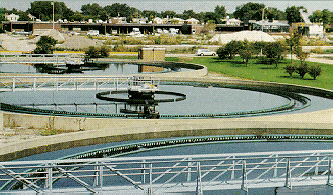Treatment Processes
Local sewers from each of the 125 municipalities within District boundaries connect to the large MWRDGC interceptors which gather the wastewater and convey it to one of the treatment plants. Here it undergoes a number of cleaning processes:
Primary Treatment
Primary treatment consists of removing contaminants by some physical mechanism:
Screens remove debris which can clog the machinery.
The wastewater flows into chambers where heavy solids such as sand and grit sink to the bottom; these solids are washed before being deposited in a sanitary landfill.

It then goes to a primary settling tank where a significant portion of the organic solids settle to the bottom while fats, oils and grease rise to the top.
Revolving "arms" simultaneously scrape the primary (untreated) solids from the bottom and skim the grease from the top.
Secondary Treatment
Secondary treatment usually employs a biological process whereby a large population of micro-organisms help convert the remaining organic material into other forms which can be easily separated into solids and a clear liquid.
The primary affluent flows through a series of large rectangular aeration tanks which have been seeded with bacteria and other microbes (tiny organisms which exist naturally in plant and animal life). Filtered air is pumped through the liquid to enable the microbes to breathe and grow. In the constantly churning water, these microbes flourish and multiply, eating the remaining organic materials and nutrients in the wastewater.
This mixture of microbes and water flows into a secondary settling tank. The microbes, now stabilized, clump together and settle to the bottom of the tank where they become part of the organic residuals and are removed. Approximately eighty-five percent of these microbes are recycled to the start of the aeration tanks to begin the biological treatment process for the primary effluent.
The cleaned water flows out of the top of the secondary settling tank to be returned to the waterway or to the tertiary treatment process.
Tertiary Treatment
Tertiary treatment is only required when the final effluent must be so clean that 95% or more of the contaminants must be removed by wastewater treatment. Tertiary treatment may include:
Filtration
Removal of Ammonia and other specific contaminants
Disinfection to destroy bacteria which can cause disease in humans.